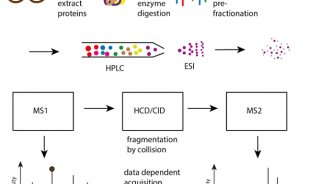蛋白质分析技术(Analytical Techniques for Protein)-3
六、SDS-PAGE
1.SDS及SDS-PAGE
(1)SDS:十二烷基硫酸钠(sodium decyl sulfate,SDS),一种阴离子去污剂,它能以一定的比例和蛋白质结合,形成一种SDS—protein的复合物。
(2)SDS- PAGE:具有SDS的PAGE,分离SDS—protein复合物,通常把这种电泳称为SDS-PAGE。
2.SDS的作用
protein (四级结构) →SDS-protein subunit
SDS-protein消除或掩盖了不同种类蛋白质分子原来电荷的差异。
SDS- protein引起蛋白质构象的变化(变成长椭圆形,短轴长度都为1.8nm,长轴长度与蛋白质分子量成正比)。
因此蛋白质在SDS-PAGE 中的泳动率不受其原来电荷和分子形状的影响,只决定于分子量。
M = k·10-bm, lgM = lgk-bm = c-bm
3. SDS-PAGE应用
测定未知蛋白质的分子量(亚基)
纯度鉴定
生物分子配基是否脱落等。
SDS-polyacrylamide gel electrophoresis, a common technique for
separating proteins at good resolution. The protein mixture first is
treated with SDS, a negatively charged detergent that binds to proteins.
This binding dissociates multimeric proteins and forces all polypeptide
chains into denatured conformations with nearly identical charge:mass
ratios. During electrophoresis, the SDS-protein complexes migrate
through the polyacrylamide gel. Small proteins are able to move through
the pores more easily, and faster, than larger proteins. Thus the
proteins separate into bands according to their size as they migrate
through the gel. The separated protein bands are visualized by staining
with a dye.
七、浓度梯度聚丙烯酰氨凝胶电泳
1.浓度梯度PAGE的结构与功能特点:聚丙烯酰胺浓度由上到下形成由低到高的连续梯度,梯度凝胶内部的孔径由上而下逐渐变小,电泳后不同分子量的颗粒停留在与其大小相对应的位置上。
2. 浓度梯度PAGE的制作过程
3. 浓度梯度PAGE的应用:测定天然蛋白质的分子量;分离和鉴定生物大分子。
八、印迹转移电泳(electrophoretic blottransfer)
1.印迹转移电泳:通过凝胶电泳将分离的蛋白质再次经过电泳,转移到固相载体表面的过程,称为~。
2.转移蛋白质的固相载体:滤纸、硝酸纤维薄膜、醋酸纤维薄膜等。常用的是硝酸纤维薄膜,其强度好、化学性质稳定。
3. 印迹转移电泳装置
4. Electrophoretic blottransfer的应用(1)检测特定的蛋白质组分(2)寻找蛋白质的相应配(3)诊断疾病的工具。
Western blotting, or immunoblotting. (a) A protein mixture is
electrophoresed through an SDS gel, and then transferred from the gel
onto a membrane. (b) The membrane is flooded with a solution of antibody
(Ab1) specific for the desired protein. Only the band containing this
protein binds the antibody, forming a layer of antibody molecules
(although their position can't be seen at this point). After sufficient
time for binding, the membrane is washed to remove unbound Ab1. (c) In
the development step, the membrane first is incubated with a second
antibody (Ab2) that binds to the bound Ab1. This second antibody is
covalently linked to alkaline phosphatase, which catalyzes a chromogenic
reaction. Finally, the substrate is added and a deep purple precipitate
forms, marking the band containing the desired protein.
九、聚丙烯酰胺凝胶等电聚焦(isoelectric focusing,IEF)
聚丙烯酰胺凝胶等电聚焦:
带电的两性电解质(如蛋白质)在pH梯度中进行电泳,根据被分离物质等电点不同而进行分离的方法,又称电聚焦(electrofocusing)或聚焦电泳(focusing electrophoresis)。
2. 聚丙烯酰胺凝胶pH梯度的形成及其等电聚焦的原理
聚丙烯酰胺 + pK和pH各自相异而又相近的两性电解质
通电形成pH梯度
蛋白质样品(两性电解质)移动到其等电点的pH区域,并在此pH环境下聚焦
3.IEF的优点:
扩散作用小;加样区域不限;样品的过分稀释也对电泳不影响。
4.IEF的应用:
测蛋白质的等电点;蛋白质的微量分析;蛋白质的纯度鉴定;鉴定蛋白质构象是否改变,是否有脱氨基等现象。
十、双向聚丙烯酰胺凝胶电泳
1.双相电泳的操作过程
先作第一相电泳
将第一相电泳后的凝胶沿电泳方向纵切成薄的长条,然后埋于第二相电泳凝胶板中进行第二相电泳(两相的电泳方向是互相垂直的)。
如果两相电泳的pH值不同,必须将第一相电泳的凝胶条放在第二相电泳的缓冲液中预先浸泡。
2.应用:复杂的样品分析、观察蛋白质空间构象改变等电泳现象差异以及用作分析抗原抗体的双相免疫电泳等。
Preparation of a two-dimensional protein gel by isoelectric focusing
(IEF) followed by SDS electrophoresis. Two-dimensional gel of protein
extracts from cells growing in a medium. Each spot represents a single
polypeptide;
polypeptides can be detected by dyes, as here, or by other techniques
such as autoradiography. Each polypeptide is characterized by its pI
(isoelectric point) and molecular weight.
Autoradiography. A radiation-sensitive photographic emulsion containing
silver salts (AgBr) is placed over tritium-labeled cells attached to a
glass slide (for the light microscope) or to a carbon-coated grid (for
the electron microscope). The cell regions containing the labeled
molecules emit radioactive particles, along the tracks of which silver
is deposited. When the photographic emulsion is developed, the silver
deposits appear as dark grains under the light microscope and as curly
filaments in the electron microscope.
十一、免疫电泳(immunoelectrophoresis)
1.定义:是把琼脂电泳和免疫扩散结合起来用于分析抗原或抗体性质的一种检测方法。
2.免疫电泳的种类
微量免疫电泳(micro immunoelectrophoresis)
火箭免疫电泳(rocket immunoelectrophoresis)
交叉电泳(crossed electrophoresis)
亲和免疫电泳(affinity immunoelectrophoresis)
十二、染色方法
(一)蛋白质的染色
1. 氨基黑10B(amino black 10B或amidoschwarz 10B或naphthalene blue black 2B 200)
amino black 10B的分子式:C22H13N6S3Na3,MW=715,λmax=620~630nm,酸性燃料。
amino black 10B与protein结合的基团:磺酸基 + Pr→复合盐
缺点:灵敏度不高;着色点不等、色调不一,误差较大。
2.考马斯亮蓝R250(coomassie brilliant blue R250,CBB R250或PAGE blue83)
CBB R250分子式:C14H44O7H3S2Na,MW=824,λmax=560~590nm
结合蛋白质的原理:通过范德瓦尔键与蛋白质结合。
优点和缺点:灵敏度高(比氨基黑10B高5倍);适用SDS-Pr染色,用于蛋白质微量分析。背景颜色深,定量不准确;对一些碱性蛋白质及低分子量蛋白质(如组蛋白)会从凝胶中洗脱。
3. 考马斯亮蓝G250
CBB G250分子式:CBB G250比CBB R250多二个甲基,MW=854,λmax=590~610nm
结合蛋白质的原理 同CBB R250
优点和缺点:同CBB R250,只是灵敏度不及CBB R250,但仍是amino black 10B的3倍;能选择地使蛋白质染色而几乎无本底色。
4.荧光染料
丹磺酰氯(dansylchloride,DNS-el)
原理:DNS-el + 蛋白质或氨基酸的NH2 →荧光性质→在320nm或280nm下 呈荧光区带或斑点
优点:蛋白质或肽经丹磺酰化后并不影响迁移率,不阻止蛋白质水解。
荧光胺(fluorescamine,fluram)
原理:同DNS-el
优缺点:没有荧光背景,易引起电泳迁移率改变(SDS可以消除此影响)。
2-甲氧基-2,4-二苯基-3-呋喃酮(MDPF)—同fluorescamine。
1-苯胺基-8-奈磺酸(ANS):本身无色,但与蛋白质结合后,在紫外光照射下产生荧光。
5. 银染色法
原理:染色机制尚不清楚,可能与摄影过程中Ag+的还原相似。
优点:灵敏度高,是CBB R250的100倍。
6.广谱燃料(stains-all)染色法
染色配方及其染色程序
缺点:灵敏度低,SDS存在下不能染色。
(二)糖蛋白的染色
1.过碘酸-Schiff试剂
2.阿尔山蓝(alcian blue)
(三)脂蛋白的染色
1.油红(oil red)
2.苏丹黑B(sudan black B)
3. 亚硫酸品红:常用于醋酸薄膜脂蛋白电泳染色,生成紫红
色脂蛋白染色带。
(四)特异酶的检测
1.酶作为蛋白质,通过电泳,定位在凝胶某一位置。
2.酶催化某些化学反应→产生颜色很深的不溶性产物→指示
酶在凝胶中的位置。
-
精英视角

-
企业风采

-
项目成果

-
综述












